Working a Subject
Photographing a species and then checking it off your list is not something that I strive to do. The idea is to create interesting images. Though each of today’s photos is of the same subject, juvenile Lesser Yellowlegs, each is distinctly different. There are a variety of behaviors, poses, habitats, and image formats and designs.
Your Call?
Which of today’s seven featured images is the strongest? Please be so kind as to leave a comment and let us know why you made your choice.
Please note that there are several additional questions below; each is designed to make you think and hopefully, to help you become a better bird photographer.
What’s Up?
With high tide at 7:20am and cloudy skies and a southeast wind forecast for Friday past, I set my alarm for 5:15am and arrived at Jamaica Bay Wildlife Refuge just after 6:15am. I had planned on visiting the East Pond on the Combo IPT on the previous set of morning high tides but things were so good at Nickerson Beach that Geri and I never made it.
As I walked out onto the pond, I was delighted to note the low water level. Kudos to the refuge management for getting the gate valve at the north end of the pond repaired and keeping the water down despite lots of recent rain. What struck me the most, were the huge stands of blossoming saltmarsh fleabane (Pluchea odorata) that covered acres and acres of shoreline. On 46 years of previous visits, you might see a few plants blossoming at the end of August.
I was feeling quite nostalgic as I traversed the pond. Forty-eight years ago, on my first visit to the East Pond, I saw a Marbled Godwit that wound up changing the remainder of my adult life. I thought of the late Thomas H. Davis Jr, all 145 pounds, 6′ 9″ of him. He taught me to identify and age the shorebirds that visit the pond every season. I thought of my late wife Elaine picking up a dying Forster’s Tern and comforting it. Memories of rare birds and two Jewish high holiday screw-ups flooded my mind and left me feeling quite emotional at times.
I was glad to see lots of shorebirds on the pond. I began on the South Flats and made my way up to the Raunt stopping several times to photograph. I left quite satisfied at about 11:00am. I hit the sack early on Saturday night and woke completely refreshed at 4:45am. I had not planned on returning to the pond but figured what the heck. After making some raspberry tea, I headed back to the East pond leaving at 5:45am.
With the wind having switched to the southwest, I was not feeling stoked. The morning began slowly but then things got better and better. I had lots of birds posing on the weathered boards at the Raunt and right before I headed home at 11:30am, I got my best ever, heck, probably my first ever, images of a Sora, a small usually secretive rail.
Today is Monday September 2, 2024. With a cold northwest wind in the forecast, I opted to stay home and begin packing up for my trip home. I see Dr. Pop tomorrow to have the seven stitches removed from the back of my right thumb. Whatever you opt to do, I hope that you choose to have fun.
Please remember to use the B&H links that are found on most blog pages and to use the BIRDSASART discount code at checkout when purchasing your new gear from Bedfords to get 3% back on your credit card and enjoy free second-day air FedEx. Please, also, consider joining a BAA IPT. You will be amazed at how much you will learn!
If an item — a Delkin flash card, or a tripod head — for example, that is available from B&H and/or Bedfords, is also available in the BAA Online Store, it would be great, and greatly appreciated, if you would opt to purchase from us. We will match any price. Please remember also to use my B&H affiliate links or to earn 3% cash back at Bedfords by using the BIRDSASART discount code at checkout for your major gear purchases. Doing either often earns you free guides and/or discounts. And always earns my great appreciation.
Supporting My Efforts Here
If you enjoy and learn from the blog, please consider using one of my affiliate links when purchasing new gear. It will never cost you a single penny. To support my effort here, please order from B&H by beginning your search here. Or, click here, to order from Bedfords and enter the discount code BIRDSASART at checkout to receive 3% cash back to your credit card and enjoy free Second-Day Air Fed-Ex shipping. It is always best to write for advice via e-mail.
In many cases, I can help you save some serious dollars. And/or prevent you from purchasing the wrong gear.
|
|
|
This image was created on 31 August 2024 at the East Pond, Jamaica Bay Wildlife Refuge, Queens, NY. Seated on damp grass and mud behind my flattened Robus RC-5570 Vantage Series 3 Carbon Fiber Tripod/Levered-Clamp FlexShooter Pro-mounted Sony FE 600mm f/4 GM OSS lens with the Sony FE 1.4x Teleconverter, and The One, the Sony Alpha 1 Mirrorless Digital Camera.. ISO 1600. The exposure was determined by Zebras with ISO on the rear wheel: 1/500 second at f/5.6 (wide open) in Manual mode. RawDigger showed the raw file brightness to be dead solid perfect. AWB at 8:12:30am on a very cloudy morning. Tracking: Expand Spot/AF-C with Bird-Eye/Face Detection performed perfectly. Click on the image to enjoy the high-res version. Image #1: Lesser Yellowlegs — worn juvenal plumage lying flat in the water |
Behavior Question
Why is this bird lying flat in the water?
|
|
|
This image was created on 31 August 2024 at the East Pond, Jamaica Bay Wildlife Refuge, Queens, NY. Seated on damp grass I used the heel-pod technique to get as low as possible with the Sony FE 600mm f/4 GM OSS lens and The One, the Sony Alpha 1 Mirrorless Digital Camera.. ISO 2000. The exposure was determined by Zebras with ISO on the rear wheel: 1/640 second at f/5.6 (stopped down one full stop for depth of field) in Manual mode. RawDigger showed the raw file brightness to be dead solid perfect. AWB at 8:15:27am on a very cloudy morning. Tracking: Zone/AF-C with Bird-Eye/Face Detection performed perfectly. Click on the image to enjoy the high-res version. Image #2: Lesser Yellowlegs — worn juvenal plumage standing |
Image Optimization Question
Images #1 and #2 are of the same bird photographed in the same light just minutes apart. For the first image, I desaturated it completely but for the yellow on the bill that was then juiced up. The color in the second image is much more accurate. Which version do you prefer?
Because of the answer to the behavior question above, this bird posed quite close to me long enough for me to remove the 1.4X TC, take the right off the tripod, and make several images. I will share my choice in the next blog post.
|
|
|
This image was created on 31 August 2024 at the East Pond, Jamaica Bay Wildlife Refuge, Queens, NY. Seated on damp grass and mud behind my flattened Robus RC-5570 Vantage Series 3 Carbon Fiber Tripod/Levered-Clamp FlexShooter Pro-mounted Sony FE 600mm f/4 GM OSS lens with the Sony FE 2.0x Teleconverter, and The One, the Sony Alpha 1 Mirrorless Digital Camera.. ISO 1600. The exposure was determined by Zebras with ISO on the rear wheel: 1/500 second at f/8 (wide open) in Manual mode. RawDigger showed the raw file brightness to be dead solid perfect. AWB at 9:05:57am on a then cloudy morning. Tracking: Zone/AF-C with Bird-Eye/Face Detection performed perfectly. Click on the image to enjoy the high-res version. Image #3: Lesser Yellowlegs — worn juvenal plumage on weathered timber with sedge |
The Raunt
About 1/4 of the way up the eastern shore of the East Pond (heading north, toward the city), you will come across the remains of a circa 1950s baymen’s community.
Many lengths of weathered timber can be found in the area. Most are covered with algae and some have a variety of wetlands vegetation growing on them. These old rotting beams and planks make ideal perches for the visiting shorebirds because you get to see their feet (usually unseen in an inch or two of brackish water).
|
|
|
This image was created on 31 August 2024 at the East Pond, Jamaica Bay Wildlife Refuge, Queens, NY. Seated on damp grass and mud behind my flattened Robus RC-5570 Vantage Series 3 Carbon Fiber Tripod/Levered-Clamp FlexShooter Pro-mounted Sony FE 600mm f/4 GM OSS lens and The One, the Sony Alpha 1 Mirrorless Digital Camera.. ISO 800. The exposure was determined by Zebras with ISO on the rear wheel: 1/500 second at f/4 (wide open) in Manual mode. RawDigger showed the raw file brightness to be perfect. AWB at 10:03:17am on a very cloudy morning. Focus was acquired via Tracking: Expand Spot AF/C. Then I turned the AF switch to M (Manual Focus) and made sure not to touch the focusing ring. Click on the image to enjoy the high-res version. Image #4: Lesser Yellowlegs — worn juvenal plumage resting in front of a stand of saltmarsh fleabane |
High Level Focusing Technique Question
Why did I focus first and then move the autofocus switch to OFF? Clue: I would not have had to do this if I had been using the a9 iii rather than the a-1.
|
|
|
This image was created on 1 September 2024 at the East Pond, Jamaica Bay Wildlife Refuge, Queens, NY. Seated on damp grass and mud behind my flattened Robus RC-5570 Vantage Series 3 Carbon Fiber Tripod/Levered-Clamp FlexShooter Pro-mounted Sony FE 600mm f/4 GM OSS lens with the Sony FE 1.4x Teleconverter, and The One, the Sony Alpha 1 Mirrorless Digital Camera.. ISO 1600. The exposure was determined by Zebras with ISO on the rear wheel: 1/1250 second at f/5.6 (wide open) in Manual mode. RawDigger showed the raw file brightness to be perfect. AWB at 10:04:13am on a cloudy morning. Tracking: Expand Spot/AF-C with Bird-Eye/Face Detection performed perfectly. Click on the image to enjoy the high-res version. Image #5: Lesser Yellowlegs — worn juvenal plumage swimming |
Swimming Shorebirds
Only a few species of shorebirds swim. Among those are all of the Tringas (including both our yellowlegs), Stilt Sandpiper, all of the avocets including our American Avocet, and somewhat surprisingly, Red Knot and Dunlin.
|
|
|
This image was created on 1 September 2024 at the East Pond, Jamaica Bay Wildlife Refuge, Queens, NY. Seated on damp grass and mud behind my lowered Robus RC-5570 Vantage Series 3 Carbon Fiber Tripod/Levered-Clamp FlexShooter Pro-mounted Sony FE 600mm f/4 GM OSS lens with the Sony FE 1.4x Teleconverter, and The One, the Sony Alpha 1 Mirrorless Digital Camera.. ISO 1600. The exposure was determined by Zebras with ISO on the rear wheel: 1/1250 second at f/5.6 (wide open) in Manual mode. RawDigger showed the raw file brightness to be perfect. AWB at 10:08:02am on a cloudy morning. Tracking: Zone/AF-C with Bird-Eye/Face Detection performed perfectly. Click on the image to enjoy the high-res version. Image 6: Lesser Yellowlegs — worn juvenal plumage on weathered timber |
Sometimes Praying Helps
The yellowlegs in Image #6 was fishing well within range of my 840mm rig. I talked softly to it, “Up on the log, please.” I prayed a bit. Then my prayers were answered.
|
|
|
This image was created on 1 September 2024 at the East Pond, Jamaica Bay Wildlife Refuge, Queens, NY. Seated on damp grass and mud behind my lowered Robus RC-5570 Vantage Series 3 Carbon Fiber Tripod/Levered-Clamp FlexShooter Pro-mounted Sony FE 600mm f/4 GM OSS lens with the Sony FE 1.4x Teleconverter, and The One, the Sony Alpha 1 Mirrorless Digital Camera.. ISO 4000. The exposure was determined by Zebras with ISO on the rear wheel: 1/1000 second at f/5.6 (wide open) in Manual mode. RawDigger showed the raw file brightness to be dead solid perfect. AWB at 11:09:21am on then very cloudy morning. Tracking: Zone/AF-C with Bird-Eye/Face Detection performed perfectly. Click on the image to enjoy the high-res version. Image #7: Lesser Yellowlegs — juvenal plumage preening in front of saltmarsh fleabane |
Sora Distraction
For two days, folk had been telling me about a Sora in a small pond on the South Flats. I had looked for it several times without success. I checked the location one last time before heading home on Sunday but did not see the bird. Thanks to the Asian woman who pointed it out to me. Typically, the Sora was playing hide and seek in the reeds that fringed the pond. When it hid, I photographed the preening Lesser Yellowlegs.
Note that this individual is in the freshest juvenal plumage of the lot with the upperparts’ feathers looking more black and white than brownish and white.
Image Question
Would you delete this image because the bird’s face is hidden? Why or why not?
Typos
With all blog posts, feel free to e-mail or to leave a comment regarding any typos or errors.

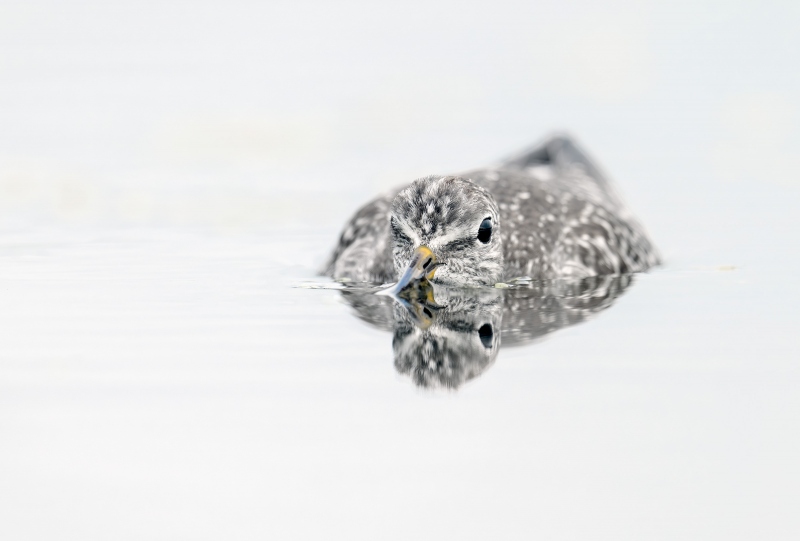
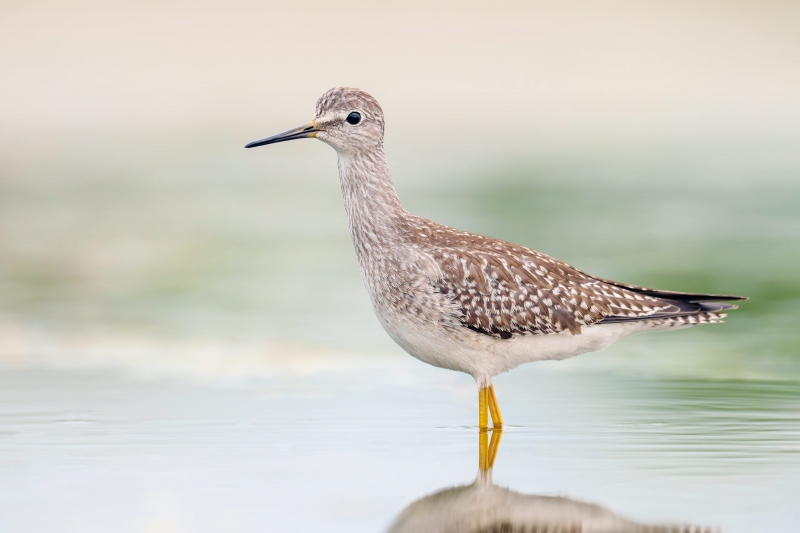
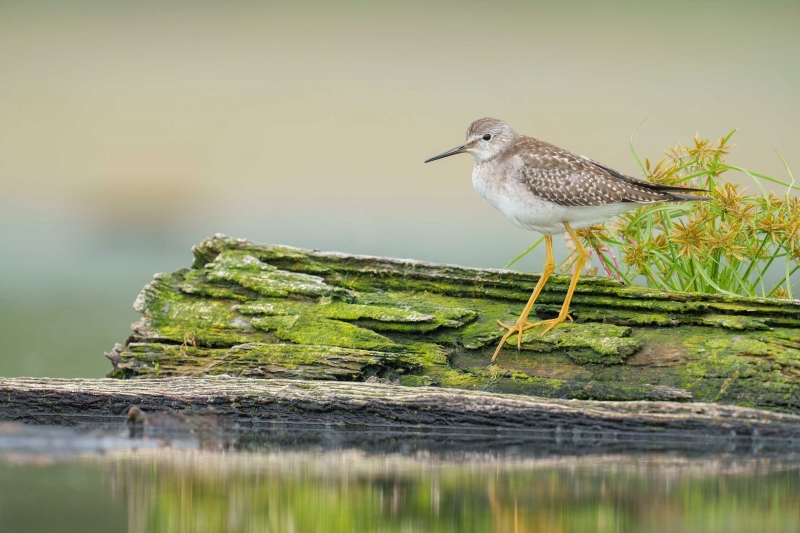
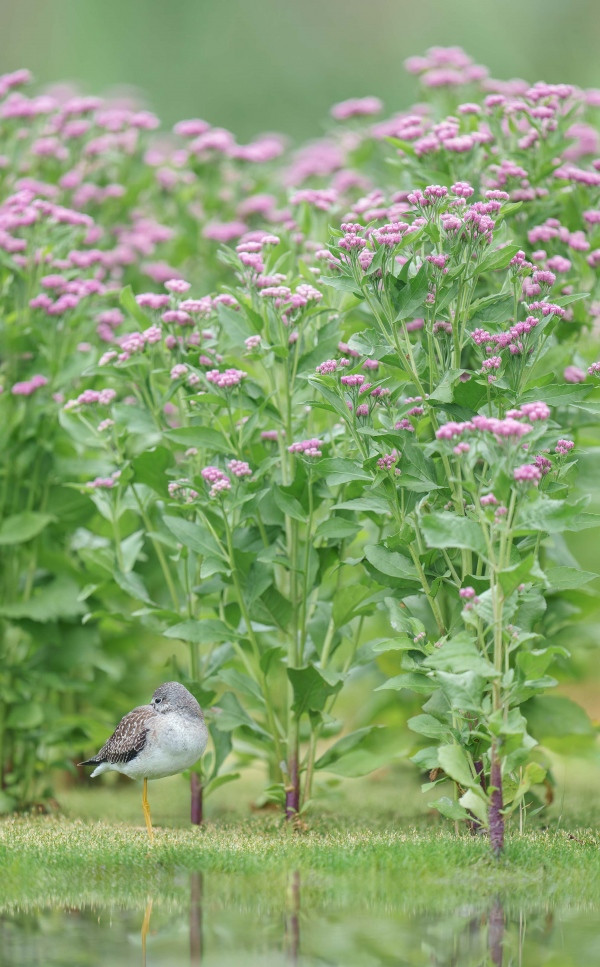
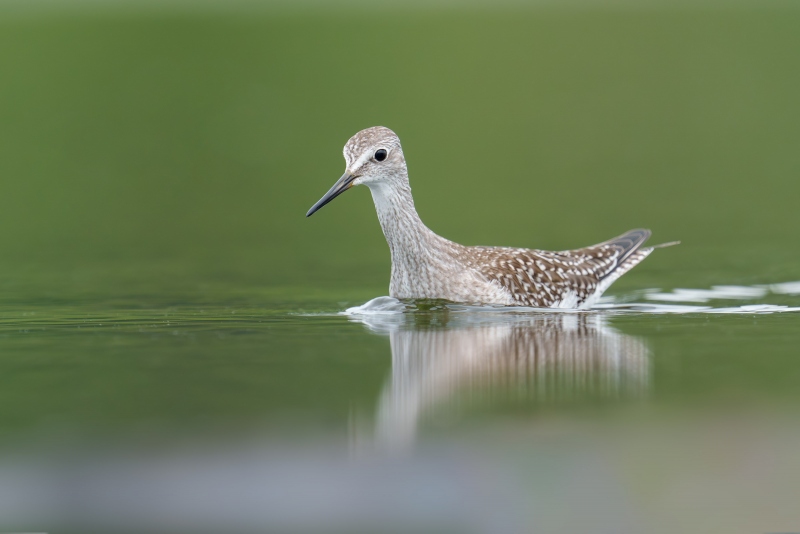
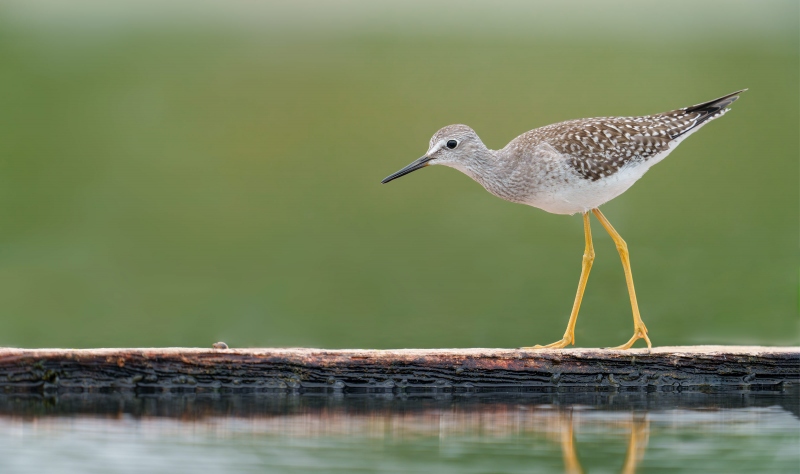
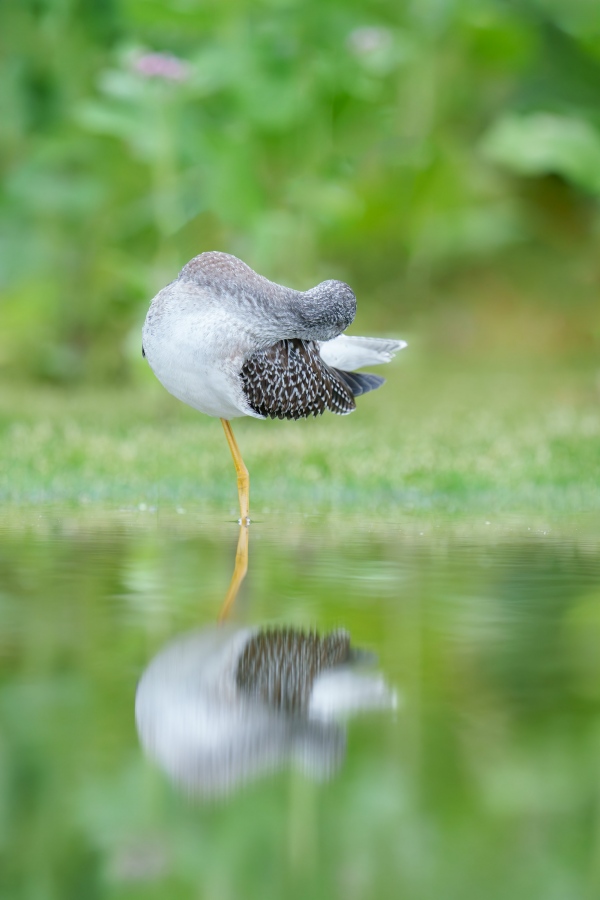













Oh boy, #4 does it for me, and by a mile (not that the others are not good). Such a unique image, with an excellent composition too. #3 is second, very appealing setting on that one too. Thanks for posting these and showing that it is worth working the same subject(s) over again – I’ve been working the same small flock of Semipalmated Sandpipers for a number of days in a row, with lots of different stuff coming out of those sessions 🙂
Thanks Dan. I saw your ethereal one and then another with six. Great stuff. #4 might be my least favorite here.
Nobody has figured out why I needed to turn AF off for that image …
with love, a
Thanks! I suppose the AF was jumping on something other than they eye when the eye was closed on this resting bird. Once you got proper focus with the eye open, you switched to MF and did not touch the focus.
Good try but that wasn’t the problem… Clue: the tripod was flattened but I was sitting …
with love, a
I’ve seen Snowy Plovers flatten when other birds on the beach were flushed, perhaps by a dog or an avian predator overhead, so I’d guess the bird in Image #1 might be showing a similar reaction, a reflexive low profile, which might also be why it hung close to the camera. I’d prefer to see color in #1 more like #2. My favorite overall is #3, which reminds me of an Audubon painting. Looks perfectly balanced as is. Second for me would be #5, the swimmer (triggers fond memories of phalaropes).
Yes to the defense against a predator — I once saw a juvenile Pectoral Sandpiper on a weathered beam flatten itself into a crack in the wood and pretty much disappear. Most likely a Peregrine or a Merlin. Thanks for your more than kind words on the photos.
with love, a
Great pic’s with plenty of green. Thanks
Whenever possible, of course 🙂
a
It’s hard to put words around why I like # 4 so much. All are beautiful images; technically perfect and composed with excellence. 4 has something else that seems in a way almost spiritual or magical. It’s a dream like quality that follows from the soft focus of the further off flowers, the reflection of the bird in still waters, and the fine aura of vegetation on which it stands. And in the midst of this, the bird coyly stands on one leg and tucks in its beak. Just lovely in every way.
Thanks, Andrew, for getting back to us on this one. And for your kind words.
much love, a
As far as I’m concerned, #4 is the clear winner.
Hey Artie, I am a big fan of somewhat abstract/unique and high key images. # 1 would be my favorite. Seems really personal, for lack of a better term. Great image!
Thanks, Frank. First vote for #1. So, what was the bird doing???
with love, artie
#6 is m favourite, the posture, the cleanliness, and the position of the subject!
Thanks, Ted. I was so, so happy when it hopped up on that log.
a
They’re all lovely though 1,6,4 are my favorites. I appreciate the quandary over image 7 and as much as I like the colors, composition, and reflection, I would likely delete. Hope the hand is continuing to improve. Happy Labor Day!
Thanks, Adam. One man’s delete is another’s favorite 🙂
a
I think image #3 is easily the best, for color and composition. I’m not crazy about all the empty space off to the left and might have cropped it a bit tighter, but overall an excellent image.
Thanks. I would not want to take anything off the left side as to my eye, the composition is perfectly balanced.
a
My favorite is #3 because of the moss and flowers which are a nice addition to the beautiful subject.
Thanks. I think that the sedge flowers are called spikelets.
a
Artie I really like images #3 and #7, after looking at both of them a number of times I think #7 is my favorite. The reflection in the pool and the touch of pink in the upper part of the frame makes for a great image; it is so peaceful and serene.
Thanks, Monte. I agree 100%. Though not sure on my favorite.
with love, artie
ps: I love the curve of the neck as well.
Artie: I had a tough time choosing between #3 (an environmental image which is a little unusual for you) and #6. I finally chose #6, after going back and forth between the images several times. I like the sharp image of the bird against the soft background and the bird’s rather precarious pose on the strip of wood.
Thanks, Pat. Note that the habitat shot you like was created at 1200mm!
with love, artie
Pat, weather has changed the behavior of the Spoonbills at Ding. None there in the morning yesterday with light rain, but I hear they were there in the afternoon instead. I’m guessing none this morning either with a heavy thunderstorm starting around 4 am. None at 7 am on the webcam. Also, on dry mornings, seems they stay longer–8:30 plus–with a low tide than with a higher tide, though the higher tide produces more clean backgrounds. If you check the Ding webcam online, choose the “mudflat” or “mudflat zoom” view–takes a minute or so for the camera to shift.